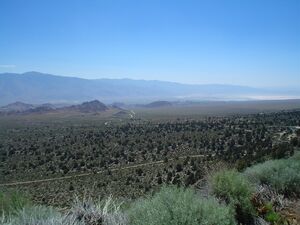Owens Valley is the arid valley of the Owens River in southeastern California in the United States. The valley is approximately 75 mi (120 km) long, trending north-south, and is bounded by the Sierra Nevada on the west and the Inyo and White Mountains on the east. The mountains on either side (including Mount Whitney) reach above 14,000 ft (4,300 m) in elevation, while the floor of the Owens Valley is at 4000 ft (1,200 m), making the valley one of the deepest in the United States. The bed of Owens Lake, now a dry alkali flat, sits on the southern end of the valley. The valley provides water to the Los Angeles Aqueduct, the source of one-third the drinking water for Los Angeles, and is famous as the scene of one of the fiercest and long-running episodes of the California Water Wars.
Historical events in Owens Valley inspired aspects of the film Chinatown.
 Owens River from Bishop Tuff tableland. |
 Owens Valley |
 Owens Valley, Alabama Hills, and Owens Lake seen from Whitney Portal Road, west of Lone Pine, CA |
The Owens Valley stretches from Haiwee Reservoir in the south to the Sherwin Summit in the north (just north of the town of Bishop). Other towns in the Owens Valley include Lone Pine, Independence and Big Pine.
Geology[]
Beginning about 3 million years ago, the Sierra Nevada and White Mountains fault systems became active with repeated episodes of slip earthquakes gradually producing the impressive relief of the eastern Sierra Nevada and White Mountain escarpments that bound the northern Owens Valley-Mono Basin region.
Owens Valley is a graben: a downdropped block of land between two vertical faults. Owens Valley is the westernmost graben in the Basin and Range Province.
The western flank of much of the valley has large moraines coming off the Sierra Nevada. These unsorted piles of rock, boulders and dust were bulldozed to where they are by glaciers during the last ice age. An excellent example of a moraine is on California Highway 168 as it climbs into Buttermilk Country.
This graben was formed by a long series of earthquakes, such as the 1872 Lone Pine earthquake, that have moved the graben down and helped move the Sierra Nevada up. The graben is in fact much larger than the depth of the valley infers; gravity studies suggest that 10,000 feet (3 km) of sedimentary rock fills the graben and that a very steep escarpment is buried under the western length of the valley. The topmost part of this escarpment is exposed as the Alabama Hills.
History[]
The Sierra Nevada casts the valley in a rain shadow, which makes Owens Valley "the land of little rain".
In 1845 John C Fremont named the Owens valley, river and lake for Richard Owens, one of his guides.
California Water Wars[]
See main article: California Water Wars
In the early 20th century the valley became the scene of a struggle between local residents and the city of Los Angeles over water rights. William Mulholland, superintendent of the Los Angeles Department of Water and Power (LADWP) planned the 223 mile (359 km) Los Angeles Aqueduct, completed in 1913, which diverted water from the Owens River. Much of the water rights were acquired through subterfuge, with purchases splitting water cooperatives and pitting neighbors against each other. The purchases led to anger among local farmers, which erupted in violence in 1924, when parts of the water system were sabotaged by local farmers.
Eventually Los Angeles acquired the water rights to over 300,000 acres (1,200 km²) of land in the valley, a quantity so great that inflows to Owens Lake were almost completely diverted. The lake subsequently dried up completely, leaving the present alkali flat which plagues the southern valley with alkali dust storms.
In 1970, LADWP completed a second aqueduct from Owens Valley. More surface water was diverted and groundwater was pumped to feed the aqueduct. Owens Valley springs and seeps dried and disappeared, and groundwater-dependent vegetation began to die.
Years of litigation followed. In 1997, Inyo County, Los Angeles, the Owens Valley Committee, the Sierra Club, and other concerned parties signed a Memorandum of Understanding that specified terms by which the lower Owens River would be rewatered by June 2003. LADWP missed this deadline and was sued again. Under another settlement, this time including the California, Los Angeles promised to rewater the lower Owens River by September 2005. As of February 2005, LADWP announced it was unlikely to meet this extended deadline.
In July 2004, Los Angeles mayor James Hahn proposed barring all future development on its Owens Valley holdings, by proposing a conservation easement for all LADWP land. As of October, 2004, Inyo County officials seem to be resisting the offer of the easement [1], perhaps due to the prior history of mistrust over LADWP actions.
One of the earliest American explorers in the area reported over "ten thousand acres [40 km²] of fine grass", but today, visitors are hard pressed to find verdant meadows.
References[]
- Deepest Valley: a Guide to Owens Valley, its roadsides and mountain trails, Jeff Putnam, Genny Smith, eds., 2nd edition, Genny Smith books, (1978), ISBN 0-931378-14-1
- Cadillac Desert, Marc Reisner, revised edition, Penguin USA, (1993), ISBN 0-14-017824-4
- Roadside Geology of Northern and Central California, Alt, Hyndman (Mountain Press Publishing Company, Missoula; 2000) ISBN 0-87842-409-1
- Geology Underfoot in Death Valley and Owens Valley, Sharp, Glazner (Mountain Press Publishing Company, Missoula; 1997) ISBN 0-87842-362-1
- The Land of Little Rain, Mary Austin, University of New Mexico Press, (1974), contains the complete text of the first edition of 1903, ISBN 0-8263-0358-7
External links[]
- The Owens Valley Committee: The Owens Valley
- Cenozoic/Mesozoic Volcanism of the Eastern Sierra Nevada
- Southern California Water: Who Does It Belong To?
- Photos of Owens Valley - Terra Galleria
- Inyo County Water Department
- Eval. of the Hydrologic System and Selected Water-Management Alternatives in the Owens Valley, California
Adapted from the Wikipedia article "Owens Valley" http://en.wikipedia.org/wiki/Owens_Valley
